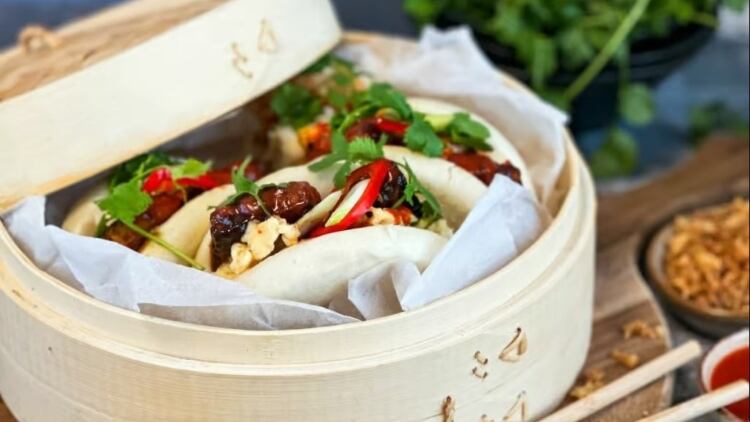The top three performing fusions for operators to consider in 2024 were Chinese, Italian, American and Indian according to Bidfood's most recent Food & Drink Report.
A recent survey by Bidfood and CGA by NIQ found 35% of consumers felt British Fusion dishes were appealing as they offered a “low risk” way to try new flavours in a format they are familiar with.
Bidfood senior research and insights executive Rhia Harry told the Morning Advertiser (MA): “The cost of living has caused many consumers to be more mindful with their spending and put quality and value for money as top of mind.
“British Fusion gives them the opportunity to explore their sense of adventure, whilst providing a safe haven of familiar flavours or formats.”
International twist
From an operator’s perspective, Harry added, British fusion style dishes enable chefs to introduce new ingredients and dishes to the menu, using “tried and tested formats”.
“Consumers still want classic British dishes from pubs, but this trend gives operators the opportunity to premiumise their menu and price points while trying out new variations without too much risk.
“A popular and versatile format is the British Fusion Pie, with 36% of consumers saying they have an interest in pie as a fusion with an international twist.”
One example of this was Indian inspired pies and pasties, such as chicken keema or Balti pies, which Harry said were beginning to feature on menus more.
In addition, she advised pies and pasties could also be a way of utilising ingredients that may otherwise be wasted.
“The traditional English breakfast is another great place to start, adding a fusion twist to this classic can not only turn it into a more premium offer, but can give it relevance for brunch, lunch and beyond.
“Our bacon and egg bao butty recipe offers an Asian twist to your typical breakfast, or perhaps swap traditional baked beans for masala beans, giving your full English an Indian twist”, she advised.
Bidfood bacon and egg bao butty

Ingredients (serves 8):
Method:
- Slice the defrosted pork. Grill or pan cook the pork with a little oil until it is caramelised. Then add the tamarind and glaze
- Steam the bao buns
- Mix the ketchup with the sriracha sauce
- Scramble the eggs and add the butter and chopped chives
- Season and serve a slice of pork belly and scrambled egg inside each bao bun with a touch of fresh coriander and spicy ketchup
In addition, the insights executive said British-Afghan, Middle Eastern, Asian and Caribbean twists were also gaining traction in the on-trade, for example with Sunday roast “platters”.
Though dessert “shouldn’t be forgotten”, she added, suggesting dishes such as earl grey cream scones that offer a sense of “British luxury”, or the addition of exotic fruits or Italian meringue to a crumble for a “touch of elegance”.
Meat-free or plant-based fusion choices were also something to consider in order to “capture a wider target market”, Harry added, while souring local ingredients was a sustainable solution operators should also focus on.
“These little changes are things that make a massive difference in terms of taste and making the dish our own, but they are not too interchanging.”
In particular, British fusion was gaining popularity with younger consumers, chef and owner of the Black Bull in Sedbergh, Cumbria, Nina Matsunaga, told the MA.
Notably, Matsunaga said she had seen an increased interest in Korean, Japanese and Mexican fusions.
Though the chef advised operators looking to incorporate fusion style dishes onto their menu to pick a cuisine they were “familiar and comfortable with”.
“It needs to be something you have tried before and can confidently say that you enjoy those flavours rather than picking something because you think it will be popular; that will never work.”
Matsunaga, who is Japanese but grew up in Germany and now lives in England, explained she takes inspiration from her heritage and childhood at the Black Bull, which is number 39 on the Top 50 Gastropubs list.
“We try and take British ingredients where we can because we're not trying to emulate something or be super authentic; it's like inauthentic authenticity but definitely fusion.
“Second and third generation cooking is quite important and quite a big thing at the minute, it's nearly its own cuisine and almost like a rebirth of fusion food.
“For example, we've made our own Miso before using black peas from Lancashire or instead of using a Japanese daikon, we use local turnips and in place of Chinese wind dried sausage, we're using a good quality homemade charcuterie or British charcuterie.

“Sometimes we use Sherry or something European based rather than an imported soy sauce product from Japan.”
To make things like dumplings, Matsunaga added, the pub sources local meat and vegetables in place of shiitake mushrooms from China alongside using things like homegrown garlic instead of Chinese three-cornered leeks.
“These little changes are things that make a massive difference in terms of taste and making the dish our own, but they are not too interchanging.”
Matsunaga added the “beauty” of fusion food was “nobody really knows what it is”, allowing chefs to explore and express their creativity while “introducing new and different flavours” to consumers.
“If you have a fusion menu, there will always be something for everyone. It's great to be able to mix [adventurous flavours and classic dishes] on one menu, there's no losing really because you can find something for everybody”, she added.
However, the chef advised pubs looking to change up their menu should start slowly to gain confidence both in the kitchen and with consumers.
“Start with something small, one or two dishes that you're confident with and just go for it, that’s the easiest way.
“If you change your menu all at once, sometimes customers can struggle, even if you're sticking to the same style of food, if you suddenly make massive menu changes customers can become wary.
Boost flavour
“Introduces little changes at a time, maybe you could introduce a snack menu [for the fusion dishes], or fusion specials, you can see how people react too, that’s a good way to go.”
Meanwhile, Dave Wall, chef patron of the Unruly Pig in Bromeswell, Suffolk, which is number one of the top 50 Gastropubs list, told the MA pubs needed to be wary of losing their “identity” when offering fusion dishes.
“Even if you choose to use fusion techniques, you might not want to have it front and centre of your offering in terms of your own identity as a brand.
“Whilst we use fusion techniques, we don't put it out there; you need to be careful not to cloud your picture and if you're going to put it to the consumer then you need to be very clear about what your brand identity is.
“If fusion is going to be something you put at the forefront, then you need to be sure that's going to be the right image you want to portray, how you want people to see you and that you’re targeting the right demographic”, he said.
Though Wall added quietly adopting fusion methods in everyday operations could prove cost-effective as the price of certain foods, namely dairy, had doubled in recent years.
He explained: “It's not a swap in swap out kind of thing, it's just the style of how we do things, we have more dressings than big heavy sauces, for example, we might use ponzus or misos that boost flavour without the need for lots of dairy.”





